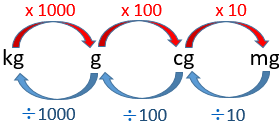How To Convert Metric To Standard Units Quickly

Converting between metric and standard units is a crucial skill in various fields, including science, engineering, and everyday applications. The metric system, also known as the International System of Units (SI), is based on the meter, liter, and gram, while the standard system uses units like inches, feet, yards, and pounds. Mastering the conversion between these two systems can save time and reduce errors in calculations. Here’s a comprehensive guide on how to convert metric to standard units quickly and efficiently.
Understanding the Basics
Before diving into the conversion process, it’s essential to understand the basic units of both systems. The metric system is based on the decimal system, making conversions within the system relatively straightforward. For instance, to convert between meters and kilometers, you simply move the decimal point. In contrast, the standard system involves more complex conversions due to its non-decimal nature.
Conversion Factors
To convert between metric and standard units, you need to know the conversion factors. These are the ratios that allow you to change from one unit to another. Here are some key conversion factors:
- Length:
- 1 meter (m) = 39.37 inches (in)
- 1 meter (m) = 3.28 feet (ft)
- 1 kilometer (km) = 0.62 miles (mi)
- Weight:
- 1 gram (g) = 0.035274 ounces (oz)
- 1 kilogram (kg) = 2.20462 pounds (lb)
- Volume:
- 1 liter (L) = 33.814 fluid ounces (fl oz)
- 1 liter (L) = 0.264172 gallons (gal)
Quick Conversion Techniques
Length Conversions:
- To convert meters to feet, multiply by 3.28. For example, 10 meters * 3.28 = 32.8 feet.
- For converting kilometers to miles, multiply by 0.62. So, 10 kilometers * 0.62 = 6.2 miles.
Weight Conversions:
- To convert kilograms to pounds, multiply by 2.20462. For instance, 10 kilograms * 2.20462 = 22.0462 pounds.
- For grams to ounces, multiply by 0.035274. Thus, 100 grams * 0.035274 = 3.5274 ounces.
Volume Conversions:
- To convert liters to gallons, multiply by 0.264172. So, 10 liters * 0.264172 = 2.64172 gallons.
- For liters to fluid ounces, multiply by 33.814. Therefore, 1 liter * 33.814 = 33.814 fluid ounces.
Practical Applications
Understanding how to convert between metric and standard units has numerous practical applications:
- Cooking and Baking: When following recipes from different parts of the world, being able to convert between units is crucial for achieving the right proportions of ingredients.
- Travel: Converting between kilometers and miles, or liters and gallons, can be essential for navigation and understanding distances and fuel consumption during travel.
- Science and Engineering: Accurate conversions are critical in scientific research and engineering projects to ensure precision and safety.
Tools and Resources
For quick and accurate conversions, several tools and resources are available:
- Online Conversion Websites: Sites like ConvertUnits.com or UnitConverters.net offer a wide range of conversion tools.
- Mobile Apps: Apps such as Unit Converter or Conversion Calculator can be downloaded for instant access to various conversion factors.
- Spreadsheet Software: Programs like Microsoft Excel or Google Sheets can be used to create custom conversion spreadsheets.
Conclusion
Converting between metric and standard units is a valuable skill that can simplify a wide range of tasks, from cooking and travel to scientific and engineering applications. By understanding the basic conversion factors and utilizing the quick conversion techniques outlined above, individuals can efficiently switch between these two systems. Whether relying on memory, online tools, or mobile apps, mastering metric to standard unit conversions can enhance accuracy, reduce errors, and save time in both personal and professional endeavors.
What is the most common mistake in converting between metric and standard units?
+One of the most common mistakes is not accurately remembering the conversion factors, leading to errors in calculations. Using incorrect conversion factors can result in significantly inaccurate results.
How can I improve my ability to convert between metric and standard units quickly?
+Practice is key. Regularly practicing conversions, especially with real-world applications, can help solidify the conversion factors in your memory. Additionally, using online tools or mobile apps can provide quick references and help build proficiency.
Are there any shortcuts or tricks for remembering conversion factors?
+Yes, creating mnemonics or using the first letter of each word in a memorable sentence can help remember specific conversion factors. For example, to remember that 1 inch is approximately 2.54 centimeters, you might use the sentence "1 Inch Nearly Equals 2.54 Centimeters" and create a mnemonic device from the first letter of each word.
By mastering the art of converting between metric and standard units, individuals can enhance their efficiency, accuracy, and understanding in a variety of contexts, ultimately making them more versatile and adept in handling different measurement systems. Whether for professional purposes or personal projects, the ability to quickly and accurately convert between these systems is a valuable asset that can simplify tasks and improve outcomes.

